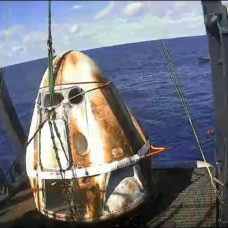In 2019, SpaceX started launching its constellation of 12,000 Starlink satellites.
The aim is to use these satellites alongside ground-based receivers to create a global broadband network. That way, the internet could become accessible to everyone across the entire planet.
As noble as the goal may seem, it does come at a cost.
Low Earth orbits satellites such as Starlinks’ often appear brighter in the night sky. As a result, they show up in astronomical images from Earth-based telescopes and interfere with dark sky surveys.
For this reason, astronomers were not too thrilled by the Starlink satellite constellation. Some even as far as describing the SpaceX satellite launch as a threat to the science of astronomy.
In a statement to the New York Times, Smith College astronomer, James Lowenthal said:
“If there are lots and lots of bright moving objects in the sky, it tremendously complicates our job. It potentially threatens the science of astronomy itself.”
In response, SpaceX launched two less-reflective models of Starlink satellites — “DarkSat” and “VisorSat.”
Launching new Darkened Starlink Satellites
In January 2020, SpaceX launched the third round of Starlink satellites.
For that launch, the company included dimmer models called DarkSat. The new version of satellites has a special anti-reflective dark coating that should reflect less sunlight.
However, according to Takashi Horiuchi of the National Astronomical Observatory of Japan, it may not have produced the desired result.
Admittedly, SpaceX’s effort to dim the Starlink constellation reduced the reflection by 50 percent. However, the researcher pointed out that it’s still bright enough to interfere with astronomy research.
Speaking to Physics World on the issue, Horiuchi said:
“The darkening paint on DarkSat certainly halves reflection of sunlight compared to the ordinary Starlink satellites, but [the constellation’s] negative impact on astronomical observations still remains.”
The more recent Starlink models — Visorsat— launched in June and August 2020 have eaves to reduce reflectivity. As such, they’re expected to be more effective than the coating on DarkSat.
Be that as it may, Horiuchi believes that raising the Satellites’ operating altitude could go a long way.



















Comments (0)
Most Recent